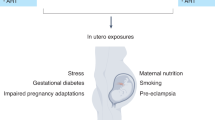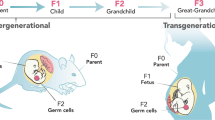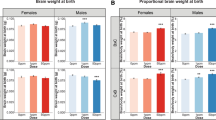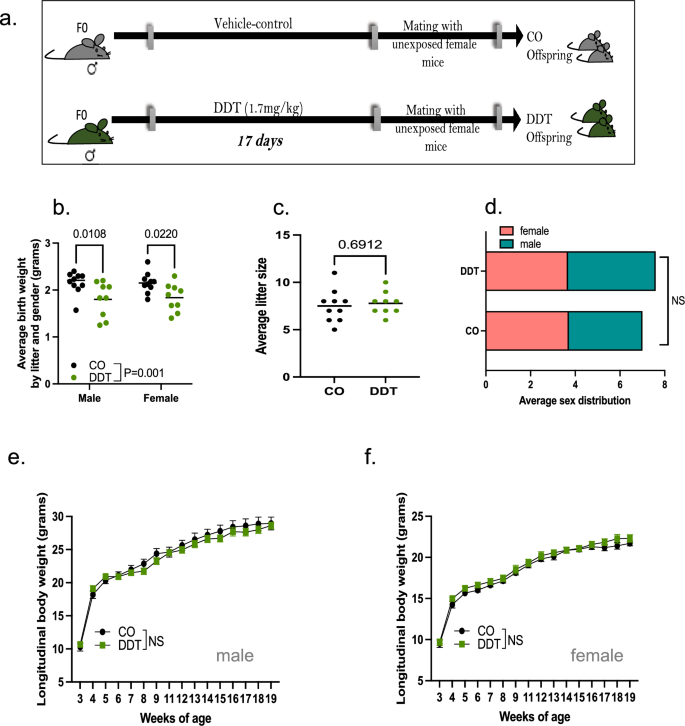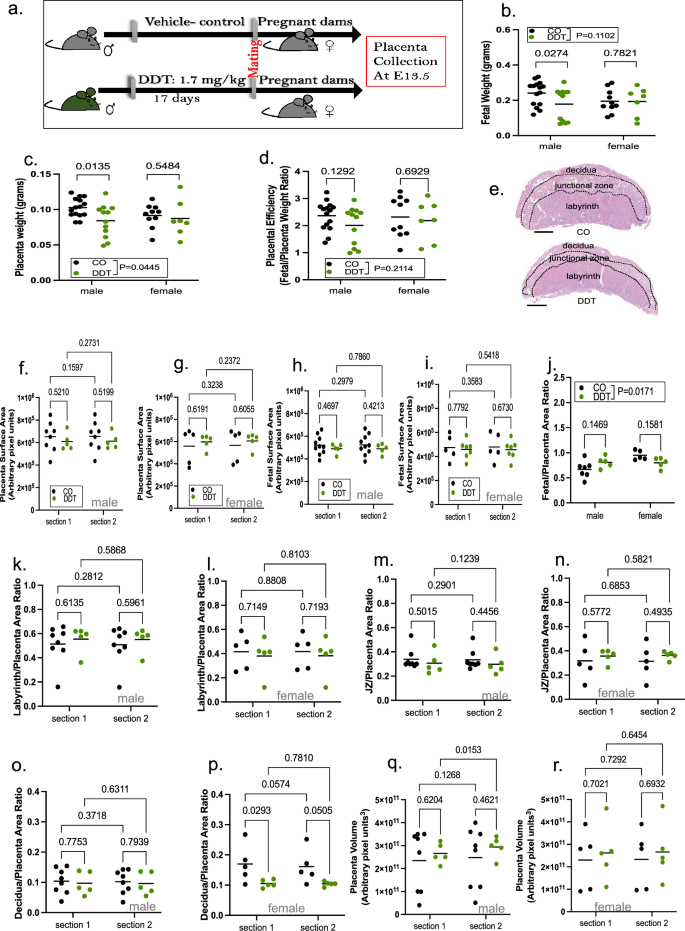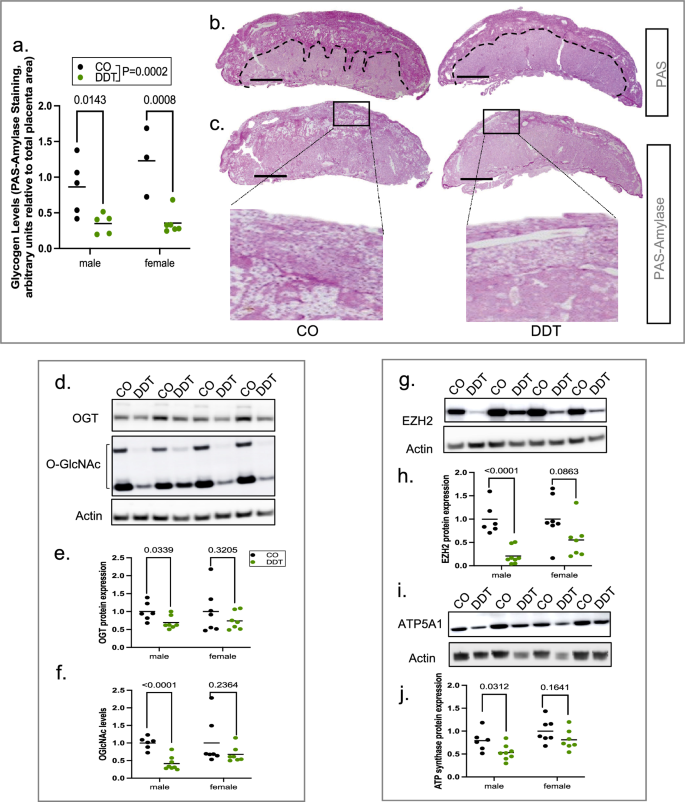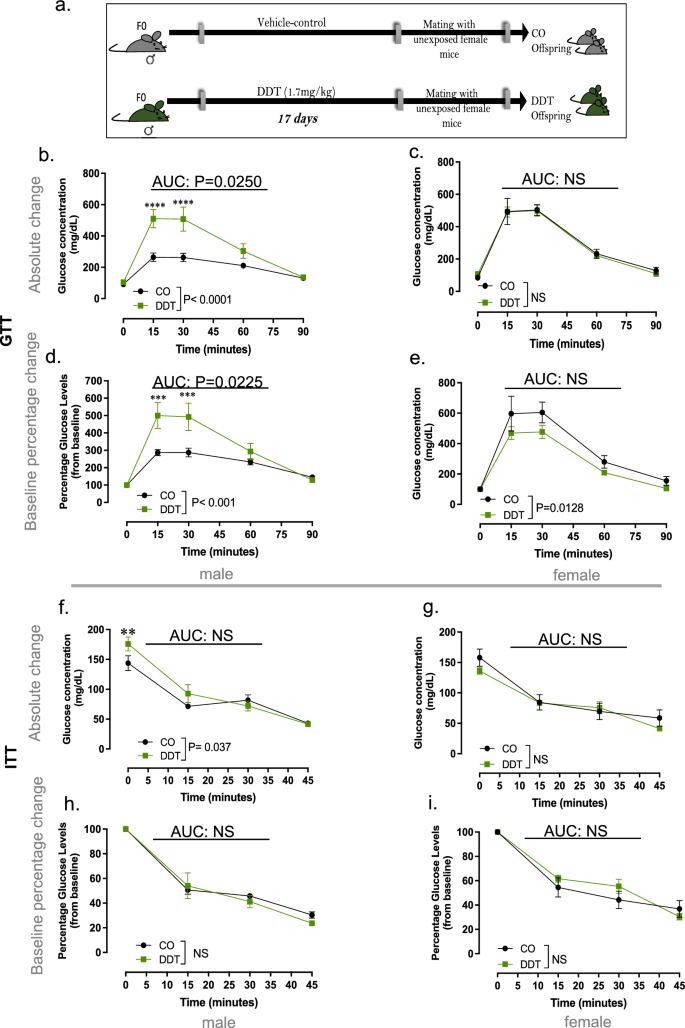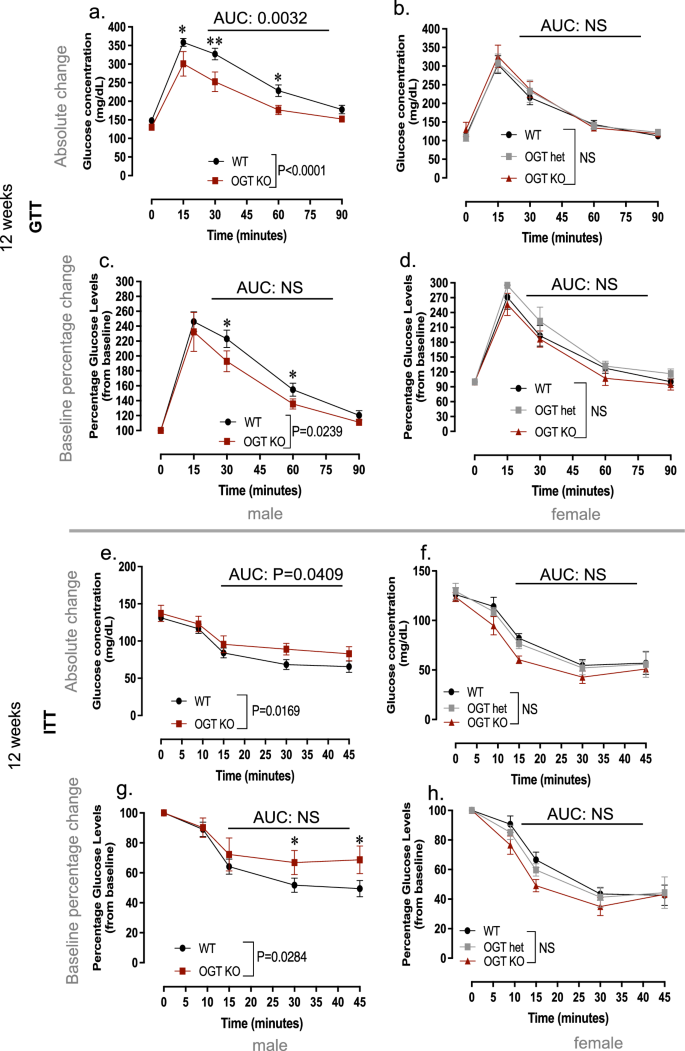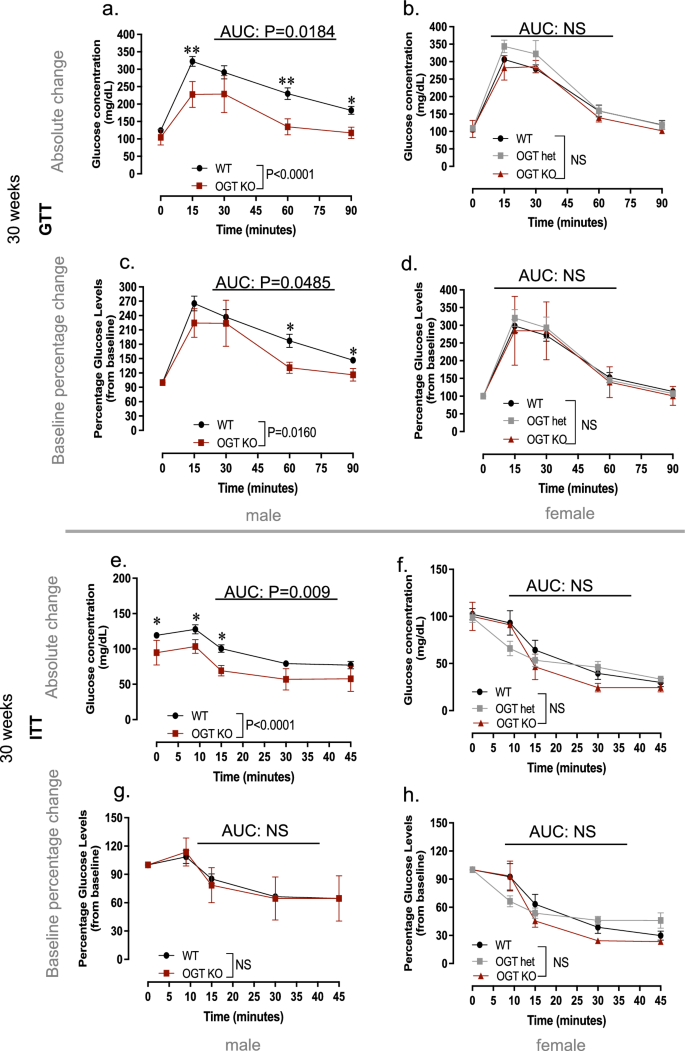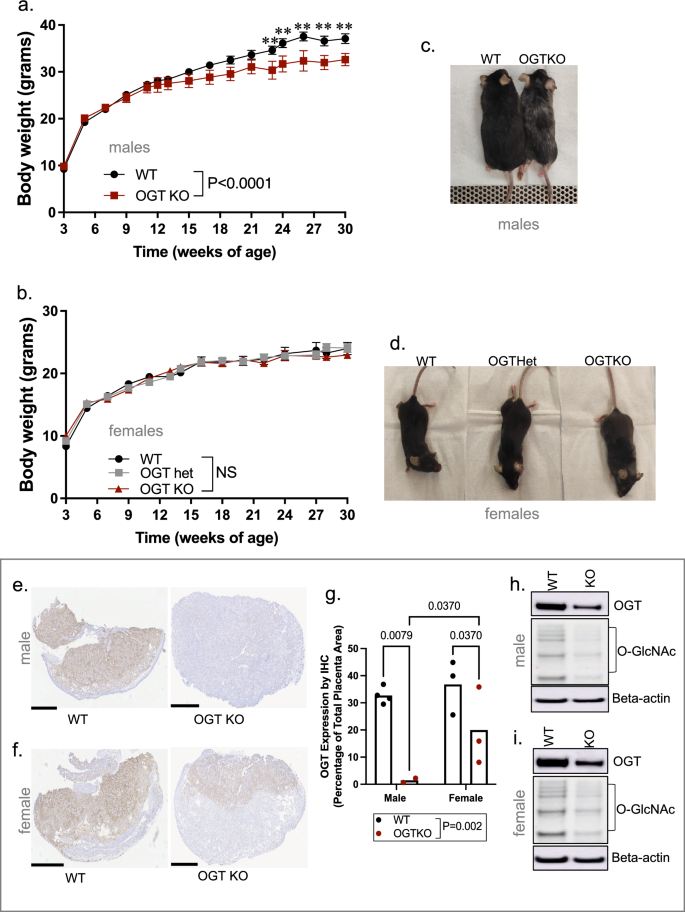Abstract
Mounting evidence suggests that environmentally induced epigenetic inheritance occurs in mammals and that traits in the progeny can be shaped by parental environmental experiences. Epidemiological studies link parental exposure to environmental toxicants, such as the pesticide DDT, to health phenotypes in the progeny, including low birth and increased risk of chronic diseases later in life. Here, we show that the progeny of male mice exposed to DDT in the pre-conception period are born smaller and exhibit sexual dimorphism in metabolic function, with male, but not female, offspring developing severe glucose intolerance compared to controls. These phenotypes in DDT offspring were linked to reduced fetal growth and placenta size as well as placenta-specific reduction of glycogen levels and the nutrient sensor and epigenetic regulator OGT, with more pronounced phenotypes observed in male placentas. However, placenta-specific genetic reduction of OGT only partially replicates the metabolic phenotype observed in offspring of DDT-exposed males. Our findings reveal a role for paternal pre-conception environmental experiences in shaping placenta development and in fetal growth restriction. While many questions remain, our data raise the tantalizing possibility that placenta programming could be a mediator of environmentally induced intergenerational epigenetic inheritance of phenotypes and needs to be further evaluated.
Similar content being viewed by others
Introduction
In eutherian mammals such as human and rodents, the placenta connects the fetus to the mother and provides the nutrient and gas exchanges necessary for optimal fetal development1,2. It also offers protection from the environment and endocrine support to the pregnancy1,2,3. This extraembryonic organ is derived from the trophectoderm, the structure forming the outer cell layer in pre-implantation embryos at the blastocyst stage2. The trophectoderm-derived cell lineage is the first lineage to appear during mammalian development. This cell lineage then gives rise to different placental trophoblast cell types. Trophoblast giant cells, for instance, are crucial for embryo implantation as they allow for infiltration into the maternal uterine epithelium and embryo attachment to the endometrium2. Upon implantation, cells in the uterus lining undergo a decidualization process that is critical for normal placentation and embryonic growth and survival4.
Although there are organizational differences between the human and the mouse placenta, the role of the major placental structures is quite similar between these two species. They also share comparable gene and protein expression patterns and, consequently, mouse models are considered excellent surrogates to study many aspects of the human placenta3. In mice, the placenta contains three main layers. The decidua is derived from the maternal endometrium while the junctional and labyrinth zones are derived from the embryonic trophectoderm2. Within the junctional zone, glycogen cells provide energetic and hormonal support for fetal growth. The labyrinth zone is the site of nutrient and gas exchange between mother and fetus2,3. Defects in both the maternally and embryonically derived layers can cause fetal growth restriction2. Abnormal placenta function not only impacts fetal growth but also offspring’s health after birth and throughout the lifespan3. A link between placenta dysfunction and maternal health in pregnancy is also well-documented3,5.
There is accumulating evidence for a placental role in epigenetic inheritance and intergenerational transmission of disease predisposition3. Because of the close relationship between mother and fetus, many studies have documented the effects of maternal experiences in pregnancy on placenta development and function5,6. Yet, despite the growing number of studies showing the importance of pre-conception paternal environmental exposures on offspring’s health, little is known about the impact of paternal experiences on placenta formation, although evidence is emerging7,8,9. Given its embryonic origin, is reasonable to expect that both paternal and maternal factors play a part in placenta development. Surprisingly, seminal studies on imprinting suggest that the process of placenta development is primarily driven by the paternal genome and epigenome while maternal genes are more important in cell and tissue development of the embryo itself10,11. In support of that, it has been reported that the paternal epigenome has a major impact in placenta formation and that paternally expressed genes are predominant in placenta12.
Epidemiological studies link pre-conception paternal exposure to persistence organic pollutants and other environmental chemicals to low birth size in offspring in humans13,14,15,16. Low birth weight is often a result of placenta defects, yet there is a lack of studies investigating the link between paternal exposure to environmental toxicants and placenta development.
Here, we developed a mouse model of preconception DDT exposure to investigate whether paternal environmental experiences reprogram placenta development, birth weight and the progeny’s later life health. We found that preconception paternal DDT exposure is linked to a decrease in birth weight and in placenta size as well as placenta-specific suppression of the nutrient sensor and epigenetic regulator OGT. Offspring of DDT-exposed fathers also show a sex-specific increase in metabolic dysfunction. However, placenta-specific genetic reduction of OGT only partially replicates the metabolic phenotype observed in offspring of DDT-exposed males.
Results
Paternal DDT exposure reduces offspring’s birth weight
When mated with unexposed female mice (Fig. 1a), DDT-exposed males produced offspring that were smaller at birth compared to controls (Fig. 1b). This is in agreement with human studies showing that parental DDT and other pesticides exposure is linked to low birth weight in offspring13. No significant differences in litter size or sex distribution were observed (Fig. 1c,d). As they aged, DDT offspring underwent a catch-up growth period and beginning at 3 weeks of age, no differences in body weight were observed between the groups (Fig. 1e,f).
Pre-conception paternal DDT exposure programs offspring’s birth weight. (a) Schematic of experimental design: Control (CO) and DDT-exposed male mice were mated to unexposed females to produce offspring. (b) Birth weight (grams) of CO and DDT offspring segregated by group and sex. (c) Average litter size and (d) sex distribution. (e–f) Longitudinal body weight (3–19 weeks of age) in male (e) and female (f) offspring. Data shown as mean (horizontal bars in scatter plots), n = 9–10 litters/group (b–d), n = 13–16 males and females/group (e–f). Data were analyzed by two-way ANOVA (b), t-test (c), Fisher's exact test (d), or repeated measures ANOVA (e,f).
Paternal DDT exposure impairs placenta growth and development
Given the small birth weight in DDT offspring, we next examined the potential impact of pre-conception paternal DDT exposure on fetal growth and placenta development. Pregnant mouse dams mated with either DDT-exposed or control males were euthanized and both placenta and fetal tissues harvested on embryonic day(E) 13.5, after placentation is complete in mice (Fig. 2a). In agreement with the low birth weight, fetal weights in the DDT group were also reduced with a significant decrease observed in male fetuses only (Fig. 2b). We also detected a decrease in DDT offspring placenta weights, with more pronounced effects in male placentas (Fig. 2c). Placental efficiency, defined as grams of fetus produced per gram of placenta, did not differ between the groups for either sex (Fig. 2d).
Paternal DDT exposure impairs fetal and placental growth. (a) Schematic of experimental design: Control (CO) and DDT-exposed male mice were mated to unexposed females to produce offspring. Pregnant dams were euthanized on E13.5 for placenta collection. (b) Fetal weight (grams) by group and sex. (c) Placenta weight (grams) by group and sex. (d) Placenta efficiency (gram of fetus per gram of placenta) by group and sex. (e) Representative picture of mouse H&E-stained placenta showing layers; bar = 0.8 mm. (f,g) Placental surface area by group and sex (f, male; g, female). (h,i) Fetal surface area by group and sex (h, male; i, female). (j) Fetus/placenta ratio by group and sex. (k–p) Layer-specific placenta surface area normalized to total placenta area and shown by group and sex: (k,l) Labyrinth zone (k, males; l, females), (m,n) Junctional zone (JZ) (m, males; n, females) and (o,p) Decidua (o, males; p, females). (q,r) Placental volume by group and sex (q, males; r, females). Placenta images were analyzed via image J software as shown in Fig. S1 and S3. Data shown as mean (horizontal bars in scatter plots), n = 19–25/group (b-d), n = 5–8/group (f, k, m, o, q), n = 5/group (g, l, n, p, r), n = 5–10 (h), n = 5–7 (i,j). Data were analyzed by two-way ANOVA (b–d,j) or repeated two-way ANOVA (f–i, k–r). section 1 and section 2 labels in f-i and k-r and refer to individual serial sections of each placenta of fetal sample analyzed.
Next, we performed placenta and fetal morphometric analysis using serial histological sections (Fig. S1a-b, Fig. 2e). We detected no significant differences in placenta (Fig. 2f,g) or fetal (Fig. 2h,i) surface area between the groups. However, we found a significant interaction between sex and group for the fetal to placenta area ratio (Fig. 2j), with a higher fetus to placenta ratio for DDT male placentas but a smaller ratio for DDT female placentas compared to controls.
It has been reported that defects in different placenta zones are associated with fetal growth restriction2. We next quantified the surface area for specific placenta layers (Fig. S2a-c). When normalizing the area for each placental layer to the total placenta surface area (Fig. 2k–p), we found no significant differences in the labyrinth (Fig. 2k,l) or junctional (Fig. 2m,n) zones between the groups. However, we observed a significant decrease in the decidua zone in female, but not male, DDT placentas compared to controls (Fig. 2o,p). We also calculated placenta volume from measurements of placenta width (Fig. S2d-e), height (Fig. S2f-g) and thickness (Fig. S2h-i), but did not find significant differences between the groups (Fig. 2q,r).
Paternal DDT exposure reduces placenta glycogen content and expression and activity of O-GlcNAc transferase (OGT)
Glucose is the major nutrient source for energy generation in the placenta. The glycogen cells within the placenta provides energetic support to the fetus2. We quantified placental glycogen content via PAS-amylase assay and normalized it by total placenta area (Fig. S4). We found a significant reduction in placental glycogen levels, independent of sex, in the DDT group compared to controls (Fig. 3a–c).
Paternal DDT exposure reduces placenta glycogen levels and expression and activity of O-GlcNAc transferase (OGT). Pregnant dams were euthanized on E13.5 for placenta collection. (a) Placenta glycogen level quantification (PAS-amylase staining, normalized by placenta area) by group and sex. (b,c) Representative pictures of PAS (b) or PAS-amylase (c) stained mouse placentas. Top area delineated by dashed lines in b depicts regions with strong PAS staining. PAS-amylase stain inset in c shows glycogen storing cells (glycogen stores appear white in section); bar = 1 mm; Images were analyzed via image J software as shown in Fig. S4. (d–f) Placenta OGT expression and O-GlcNAc levels: (d–f) Representative Western-Blots (males) showing OGT expression and O-GlcNAcylation levels with beta-actin as loading control; (e–f) Quantification of placenta OGT and O-GlcNAc levels by group and sex (e,f). (g,h) Placenta EZH2 expression levels: (g) Representative Western-Blots (males) showing EZH2 expression with beta-actin as loading control; (h) Quantification of placenta EZH2 expression by group and sex. (i,j) Placenta ATP synthase (ATP5A1) expression levels: (i) Representative Western-Blots (males) showing ATP5A1expression with beta-actin as loading control; (j) Quantification of placenta ATP5A1by group and sex. Data shown as mean (horizontal bars in scatter plots), n = 8–11/group (glycogen levels); n = 13–15/group (western-blots). Data were analyzed by two-way ANOVA (a) or t-test (e,f,h,j). Full-length Western-Blots membranes (male and female placentas) are shown in Fig. S5-6.
Reasoning that reduced glycogen levels could disrupt energy sensing activity in placenta, we next examined the levels and activity of OGT (O-Linked N-Acetylglucosamine [GlcNAc] transferase). This enzyme is a nutrient sensor and its activity is dependent on glucose flux through the hexosamine biosynthetic pathway17,18. OGT plays an important role in placenta development and function19. Indeed, we found that both OGT protein levels and OGT-catalyzed protein O- GlcNAcylation were reduced in placentas of DDT offspring (Fig. 3d–f).
OGT is an X-linked gene. Placenta displays sexual dimorphism in X-linked genes becasue X chromosome inactivation is malleable in female placentas20. Indeed, we found that paternal DDT associated reduction in placental OGT expression and O-GlcNAcylation was sex-specific and more pronounced in male placentas (Fig. 3e,f). Importantly, sexual dimorphism in the expression of OGT has also been reported in human placentas6.
As a O-GlcNAc transferase, OGT plays a key role in many biological processes via posttranslational modification and stabilization of both cytosolic and nuclear proteins18. For instance, OGT controls chromatin remodeling by mediating histone methylation via stabilization of the histone methyltransferase EZH221. Consistent with lower levels of OGT and O-GlcNAcylation, levels of EZH2 protein were significantly reduced (Fig. 3g,h) in placentas of DDT offspring, particularly in male placentas.
Another documented target of OGT is ATP synthase subunit alpha (ATP5A1)22, a protein that is part of a complex that controls energy levels in the form of ATP to fulfill the bioenergetic function of the placenta. Although not as pronounced as EZH2, we also found a sex-specific reduction of ATP synthase protein levels, with a more marked decreased in DDT male offspring placentas compared to controls (Fig. 3i,j).
Paternal DDT exposure programs metabolic dysfunction in offspring
Small birth weight has been associated with chronic diseases such diabetes later in life23. Given this relationship, we next examined whether paternal DDT exposure increased metabolic dysfunction in the progeny ages 8–10 week of age. Indeed, DDT offspring showed poor metabolic function in adulthood, with a sex-specific effect (Fig. 4a–i). Male DDT offspring displayed severe glucose intolerance compared to controls (Fig. 4b,d). In contrast, female DDT offspring showed a small but significant better glucose handling than control females (Fig. 4c,e).
Paternal DDT exposure programs metabolic dysfunction in offspring. (a) Schematic of experimental design: Control (CO) and DDT-exposed males were mated to unexposed females to produce offspring. Metabolic function in offspring of CO and DDT-exposed males at 8–10 weeks of age: (b–e) Glucose tolerance test (GTT) shown as absolute glucose values (b,c) or percentage change from baseline (d,e) in male (b,d) and female (c,e) offspring; (f–i) Insulin Tolerance Test (ITT) shown as absolute glucose values (f-g) or percentage change from baseline (h,i) in male (f,h) and female (g,i) offspring. Data shown as mean ± SEM; n = 9 males and females/group (b–e), n = 8–9 males and females /group (f–i). GTT or ITT curves were analyzed by repeated measures ANOVA. AUC data was analyzed by t-test.
Although male DDT offspring had higher baseline glucose levels after a 4-h fast, no differences in insulin sensitivity were observed between the groups for either males or females. (Fig. 4f–i).
Placenta-specific genetic deletion of OGT partially replicates the effects of paternal DDT on offspring metabolic function in a sex specific manner.
To examine whether suppression of OGT activity in placenta was functionally linked to programming of metabolic dysfunction in DDT progeny, we used a mouse Cre -Lox system for placenta-specific genetic deletion of OGT (Figs. 5a–h and 6a–h).
Placenta-specific genetic deletion of OGT does not fully replicate the effects of paternal DDT on offspring metabolic function at 12 weeks of age. (a–h) Metabolic function in WT and OGTKO mice at 12 weeks of age: (a–d) Glucose tolerance test (GTT) shown as absolute glucose values (a,b) or percentage change from baseline (c,d) in male (a,c) and female (b,d) offspring; (e–h) Insulin Tolerance Test (ITT) shown as absolute glucose values (e–f) or percentage change from baseline (g,h) in male (e,g) and female (f,h) offspring. Data shown as mean ± SEM; (a–d) n = 21 (WT males and females), n = 9 (OGTKO males and females), n = 5 (OGThet); (e–h) n = 19 (WT males and females), n = 9 (OGTKO males and females), n = 6 (OGThet females); ITT and GTT data were analyzed by repeated measures ANOVA (a–h). AUC data was analyzed by t-test (a,c,e,g) or one-way ANOVA (b,d,f,h).
Placenta-specific genetic deletion of OGT does not replicate the effects of paternal DDT on offspring metabolic function at 30 weeks of age. (a–h) Metabolic function in WT and OGTKO mice at 30 weeks of age: (a–d) Glucose tolerance test (GTT) shown as absolute glucose values (a,b) or percentage change from baseline (c,d) in male (a,c) and female (b,d) offspring; (e–h) Insulin Tolerance Test (ITT) shown as absolute glucose values (e,f) or percentage change from baseline (g,h) in male (e,g) and female (f,h) offspring. Data shown as mean ± SEM; (a-h) n = 16 (WT males and females), n = 5 (OGTKO males and females), n = 8 (OGThet females); ITT and GTT data was analyzed by repeated measures ANOVA (a-h). AUC data was analyzed by t-test (a,c,e,g) or one-way ANOVA (b,d,f,h). ITT and GTT data were analyzed by repeated measures ANOVA (a–h). AUC data was analyzed by t-test (a,c,e,g) or one-way ANOVA (b,d,f,h).
Though male offspring with placenta-specific OGT deletion (OGTKO/Y) genotype showed metabolic dysfunction, their phenotype only partially replicated that of DDT male offspring (Fig. 5a,c,e,g). While placenta OGTKO/Y male offspring had higher absolute glucose levels after a 4-h fast and an increase in insulin resistant in early adulthood (Fig. 5e,g), they showed better glucose handling than WT control male littermates (Fig. 5a,c). Female offspring with placenta-specific OGT reduction (OGTKO or OGThet) showed no signs of metabolic dysfunction compared to WT littermates at 12 weeks of age (Fig. 5b,d,f,h).
Because metabolic dysfunction tends to worsen with age24, we repeated metabolic assessments at 30 weeks of age (Fig. 6a–h). Placenta OGTKO/Y males continued to show better glucose tolerance compared to WT males (Fig. 6a,c). However, no differences in insulin sensitivity were observed between males with different placenta genotypes, despite the lower baseline glucose levels in OGTKO/Y males at this age (Fig. 6e,g). Metabolic function in placenta OGT KO or OGThet female offspring did not differ from WT littermates at 30 week of age (Fig. 6b,d,f,h).
Placenta-specific genetic deletion of OGT impacts offspring body-weight gain with age in a sex specific manner
To better understand what metabolic phenotypes observed in offspring with placenta-specific OGT reduction, we evaluated their body weight compared to WT mice from weaning to 30 weeks of age (Fig. 7a–d). While placenta OGTKO/Y and WT males displayed similar body weight gain until about 12 weeks of age, OGTKO/Y males did not gain as much body weight after this time point compared to WT controls, weighing significantly less by 24 weeks of age (Fig. 7a,c). Not surprisingly, there were no differences in body weight in placenta OGTKO or OGThet female offspring compared to WT controls (Fig. 7b,d).
Placenta-specific genetic deletion of OGT impacts offspring’s bodyweight in a sex specific manner. (a,b) Longitudinal body weight (3–30 weeks of age) in (a) WT or OGTKO males and in (b) WT, OGThet or OGTKO females. Representative pictures showing (c) WT or OGTKO males and (d) WT males OGThet or OGTKO females at 30 weeks of age. (e,f) Representative pictures showing OGT protein immunostaining in placentas of (e) males or (f) females with a WT or OGTKO genotype; bar = 1 mm; (g) Quantification of placenta OGT protein immunostaining by group and sex. (h,i) Representative Western-Blots showing OGT protein expression and O-GlcNAcylation levels in placentas of (h) males or (i) females with a WT or OGTKO genotype; beta-actin, loading control. Data shown as mean ± SEM (a,b) or mean (g); Body weight data were analyzed by repeated measures ANOVA; n = 16 (WT males and females), n = 5 (OGTKO males and females), n = 8 (OGThet females). OGT immunostaining quantification was analyzed by two-way ANOVA; n = 5 (WT placentas), n = 7 (OGTKO placentas). Full-length Western-Blot membranes are shown Fig. S7.
Because OGT is an X-linked gene, we wondered whether placenta Cre recombinase mediated OGT deletion is more efficient in males than in females in this model. We found that this is indeed the case. In OGTKO/Y male placentas, OGT protein expression and activity is almost completely lost (Fig. 7e,g,h). While placenta OGTKO females showed a decreased in OGT expression and activity (O-GlcNAcylation levels) compared to the WT group (Fig. 7f,g,i), they still retained higher expression levels of OGT protein compared to OGTKO/Y male placentas.
Discussion
Using a mouse model, we found that preconception paternal DDT exposure is linked to a decrease in the progeny’s birth weight and reduced placental size. We also observed a reduction in placental glycogen levels and the nutrient sensor and epigenetic regulator OGT, with more pronounced phenotypes observed in male placentas. The progeny of DDT-exposed males also exhibited sexual dimorphism in metabolic function, with DDT male offspring developing severe glucose intolerance while DDT female offspring show slightly better glucose handling compared to controls. However, placenta-specific genetic reduction of OGT only partially replicates the metabolic phenotype observed in offspring of DDT-exposed males.
Our findings are consistent with epidemiological studies linking parental exposure to persistence organic pollutants and other environmental chemicals to low birth size in offspring in humans13,14,15,16,25. In our model, the reduced birth weight in offspring of DDT-exposed males was associated with impaired fetal growth and placenta weight.
There is accumulating evidence for placenta as a mediator of environmentally-induced intergenerational transmission of disease3. Given the tight connection between the fetus and the mother during gestation, it is well documented that maternal experiences in pregnancy impact placenta development and function5,6. In our paradigm, paternal exposure to the environmental toxicant DDT also impaired placenta development, its glycogen storage and nutrient sensing signaling.
In humans and mice, the inner cell mass and the trophectoderm— the layer containing cells that give rise the placenta and other extraembryonic tissues— are the first definitive embryonic cell lineages to appear3. The integrity and function of the trophectoderm is critical for the blastocyst-stage embryo implantation and pregnancy success. Defective placentation can result in fetal growth restriction and other pregnancy complications26,27. Although details need to be elucidated, our data suggest that pre-conception paternal environmental exposures can contribute to disruption of this process and lead to defective placentation.
Abnormal placenta function and adverse events in fetal development have been associated with disease later in life. In this study, we found that paternal exposure to DDT also results in metabolic dysfunction and poor glucose handling in the male, but not female, progeny. Interestingly, both human and animal studies link maternal exposure to DDT to metabolic dysfunction in the next generations28,29,30. These findings, along with previously published reports, suggest that paternal exposures may be as important as maternal ones regarding determination of the progeny’s phenotypes. This striking overlap between the impact of maternal or paternal exposure on offspring phenotypes has been noted by others31, and our current findings raise the possibility that the placenta may be the common mediator of intergenerational epigenetic inheritance of phenotypes.
OGT is encoded by an X linked-gene and is a key regulator of several biological processes through its posttranslational modification of both nuclear and cytosolic proteins. Unlike other somatic tissues, the inactivation of the X chromosome in the placenta is plastic, allowing for its reactivation in response to stress20,32. It has been proposed that this is the reason why female fetuses can be more resilient to environmental stressors33. Our findings are in line with this concept as paternal DDT exposure has greater impact on placenta of male fetuses and suppresses placenta OGT signaling in a sex-specific manner. Importantly, this sexual dimorphism in placenta OGT expression has also been reported for maternal exposures6, further strengthening the notion that placenta abnormalities could mediate both paternal and maternal effects on the progeny.
In our study, placenta OGT reduction did not fully replicate the metabolic dysfunction observed in DDT offspring. It is possible that the divergent metabolic phenotypes between DDT offspring and placenta OGT KO offspring is due to timing. While in the placenta OGTKO mouse model used here, Cre-induced genetic knockdown occurs early in development34, it’s possible that OGT suppression in placenta of DDT offspring is a later event in the placentation process, though this still needs to be investigated. In males, the X chromosome is maternally inherited. This further supports the notion that placental reduction in OGT expression and activity observed in DDT male progeny, which also show abnormal glucose homeostasis, is a secondary event and not directly inherited from the paternal genome. Yet, we cannot completely rule out that other factors inherited from the paternal sperm play a role.
OGT and its biochemical mark, O-GlcNAcylation, play a role in placentation through its regulation of syncytiotrophoblast formation. In BeWo trophoblast cells, OGT depletion via siRNA leads to spontaneous differentiation35. Although it does not completely phenocopy the poor glucose handling in DDT male offspring, it is possible that OGT genetic reduction in the early trophectoderm causes a more serious disruption in placentation than observed in the paternal DDT paradigm. This likely leads to suboptimal fetal development and more severe health phenotypes such as impaired body weight gain and neurodevelopmental disorders6 later in life. While not described in this report, our early findings suggest that placenta OGT genetic deletion results in in many other health alterations in offspring as they age.
Why OGT genetic reduction results in sex specific effects on metabolic homeostasis is not entirely clear. However, the fact longitudinal body weight of OGTKO and OGThet females does not differ from the control littermates unlike OGTKO/Y males offers a clue. We also showed that OGTKO females retain some degree of OGT expression in placenta, likely due to incomplete recombination, which could be enough to provide protection. It is possible that the sexual dimorphism observed in body weight in older OGTKO offspring could be due to accelerated aging in male mice, though confirmation studies are needed. Interestingly, in mouse models of aging, impaired body weight gain is caused by loss of bone and muscle mass. In these models, sex-specific difference has been reported because estrogens can protect female mice from sarcopenia36. It has also been reported that placenta EZH2, an OGT target, is responsible for the female fetus resilience to maternal stress37. However, whether this epigenetic modifier plays a role in the observed sex-specific phenotypes still need to be investigated.
Employing the same placenta-specific OGTKO mouse model used here, a recent study38 found no differences in glucose homeostasis in males 6–8 weeks of age or fed a high-fat diet, but reported an increase in insulin sensitivity in OGThet placenta females after a 12-week course of high fat diet. This was associated with increased hepatic insulin/Akt axis signaling. The study also reported a decrease in pancreatic islet size for mice with placenta-specific OGT knockout compared to the controls but this was compensated by an increase in the total number of islets. While both of our studies found better glucose handling in mice with placenta-specific OGT reduction, this phenotype was detected exclusively in males in the present study. Differences between our studies likely stem from the timing of metabolic testing and different dietary conditions. In the present study, mice were kept on chow diet throughout the study while in the Moore et al. study, mice were switched to a high-fat diet at 12 weeks of age. We also backcrossed the original FBV Cyp19-Cre mice into the c57bl6 background, which could further explain the phenotypic differences between the two studies.
A recurring finding in our study is the sex-specific outcomes with more pronounced phenotypes in male DDT offspring. This is supported by other literature reports showing that the impact of parental exposures on offspring health is often sexually-dimorphic. In humans, in utero tobacco smoke exposure is linked to greater severity of disease in females39. In rodents, female offspring from obese mothers show better hepatic functioning that protect them from adverse health effects observed in males40. In contrast, female offspring of fathers exposed to morphine have worse memory deficits compared to male offspring41. This parentally-induced sexual dimorphism on offspring’s health extends to placenta phenotypes and seems dependent on the environmental stressor. Animal models show that maternal exposure to benzene or stress leads to sex-specific transcriptional changes in placentas42,43 while paternal obesity leads to placenta hypoxia in female placentas9.
Sex differences in progeny’s phenotypes in response to parental experiences can be attributed to sexual dimorphism associated with sex chromosomes. Placenta X chromosome inactivation (XCI) is imprinted with preferential inactivation of the paternal X chromosome. However, selective inactivation of the paternal X chromosome in female placenta has been reported and can lead to gene dosage differences between the sexes. The OGT gene, for instance, has been show to escape XCI and show higher expression in female placenta in both humans and mice43,44,45. Additional mechanisms that contribute to sex-specific differences in offspring phenotypes include sex hormones (which can impact the both gene expression and gut microbiota) and difference in mitochondrial function33,45,46.
While we showed a link between paternal DDT exposure and programming of placenta development, the environmentally-induced paternal factors involved in placenta development need to be fully evaluated. In our model, mating of DDT-exposed males with unexposed females was performed overnight and offspring and placenta traits likely stem from changes in the sperm epigenome as reported before. The impact of environmental factors on the sperm epigenome, particularly sperm RNAs, has been well documented by us and others47,48,49,50,51. However, whether and how the sperm epigenome plays a role in placenta development remains to be investigated. DDT has been reported to be a mutagen at very high doses52 and though the low DDT dose used in this study is likely non-genotoxic, we cannot completely rule out genetic abnormalities in paternal sperm.
Our study also has other limitations. The Cyp19-Cre line used to genetically suppress OGT expression in placenta can be inefficient. Two recent publications report that Cyp19-Cre activity in placenta is quite variable, with only about a third of maternally inherited Cyp19-Cre leading to recombination levels of 70% or greater53,54. In addition, we cannot completely rule out a confounding effect of the mixed genetic background in OGTKO offspring, which could have impacted placental OGT expression as well as the progeny’s metabolic phenotypes. Thus, results obtained using the OGTKO model require conservative interpretation.
Despite these limitations and remaining questions, our study show that preconception paternal DDT induced alteration in offspring is linked to placenta defects. Our findings, along with recent reports7,9, raise the tantalizing possibility that placenta programming is a mediator of environmentally induced intergenerational inheritance of phenotypes and needs to be further evaluated.
Materials and Methods
DDT exposure and breeding
The C57BL/6NTac strain of mice (Taconic Biosciences) was used in this experiment. Adult male mice (8 weeks of age) were either treated daily with a DDT solution (1.7 mg/kg) or vehicle-control solution (peanut oil) via oral gavage for 17 days. Duration of exposure was chosen in order to encompass the entire period of post-testicular sperm transit in the epididymis (which takes about 15 days in mammals), the last stage of sperm maturation55. The DDT solution used mimics the formulation of DDT before its ban in the U.S.: 77.2% p,p’-DDT and 22.8% o,p’-DDT as described before29.
At the end of the exposure period, DDT or vehicle-control exposed male mice were mated overnight to unexposed females to generate the offspring. Pregnant dams were allowed to deliver their offspring or euthanized on embryonic day (E)13.5 for placenta collection as described below. All mice utilized in this study were kept on a standard chow diet including the exposures and breeding periods, for the extent of pregnancy (21 days) and after birth. To avoid litter-effect, pups were cross-fostered one day after birth. All pups were weaned on postnatal day (PND) 21. The offspring of control-vehicle or DDT-exposed fathers were used to study metabolic function as described in the following sections.
The number of offspring/litters stemming from different fathers included in each experimental endpoint is shown in Table S1.
All animal procedures were approved by the Georgetown University Animal Care and Use Committee, and the experiments were performed following the National Institutes of Health guidelines for the proper and humane use of animals in biomedical research. Animals were randomized to each exposure group and treatments were performed blindly. The study is reported in accordance with ARRIVE guidelines.
Placenta harvest
Non-exposed female mice were mated with DDT or vehicle-control exposed males overnight as described above. Mating was confirmed by detection of a vaginal plug. This was considered the first day of pregnancy or embryonic day (E) 0.5. Pregnant dams were housed in groups of two with free access to food and water and euthanized either on E13.5, after placentation is complete in mice. Placentas and fetuses were weighed upon dissection and either snap frozen or fixed in 10% neutral-buffered formalin. DNA from fetal tail tips were used for gender determination via commercial genotyping (Transnetyx, Inc.) of the Y chromosome specific gene, SRY.
Placenta morphometric, cellular and molecular assessments
Morphometric assessment
Placenta surface area, width, height, and thickness and volume were evaluated using two placenta sections per sample in the Image J Fiji image processing software. Morphometric ends points were total placental surface area and surface area of each placental layer (labyrinth, junctional zone and maternal decidua). The detailed methodology is shown in Fig. S1a. Briefly, an image outline of each individual mid-sagittal serial placenta section (PAS staining) was traced using the Image J software tracing function. The number of pixels in the selected area was then calculated by the software. These procedures were then repeated to determine the area of each specific placenta layer.
We also estimated the dimensions (width, height, and thickness) of each mid-sagittal placenta section image, using Image J software tracing function and resulting number of pixels as illustrated in Fig. S3. Placenta volume was calculated from measurements of width, height, and thickness using a formula adapted from Azpurua et al.56.
To assess placental efficiency, defined as the gram of fetus per gram of placenta, the weight of each individual fetus was divided by its placenta weight.
Glycogen assessment
Placenta glycogen content was measured via periodic acid–Schiff (PAS) staining, with or without α-amylase digestion, using a commercial PAS staining system (Sigma-Aldrich, catalog #395), according to manufacturer’s instructions. To quantify placenta glycogen levels, two serial PAS-stained placenta sections (with and without alpha-amylase treatment) were analyzed using the ImageJ Fiji image processing software. Using the H PAS function within ImageJ, color filters were separated, and then the intensity of PAS staining (pixels) was quantified for both section images. Glycogen levels were measured using the difference in color intensity between images without and with amylase and normalized by total placenta area (Fig. S4).
Molecular assessments
Protein levels of OGT, EZH2, ATP5A1 and patterns of protein O-GlcNAcylation were assessed via Western-Blot (as described below) in placenta (See Table S2 for list antibodies and dilutions).
The number of samples/litters stemming from different fathers included in placenta endpoint is shown in Table S1.
Fetal morphometric assessment
Fetal surface area was assessed using two embryo sections per sample in the Image J Fiji image processing software. The detailed methodology is shown in Fig. S1b. Briefly, an outline of each individual mid-sagittal fetal section image (H&E staining) was traced using the Image J software tracing function. The number of pixels in the selected area was then calculated by the software.
Assessment of longitudinal body weight and metabolic parameters in offspring
Offspring of vehicle-control or DDT exposed males were weighed one day after birth and weekly starting at weaning (3 weeks of age) and monitored until 20 weeks of age.
Glucose tolerance test (GTT) and insulin tolerance test (ITT) were performed in 8 to10 week-old mice. For the GTT, mice were fasted for 6 h, injected i.p. with glucose (2.5 g/kg) and glucose measurements taken at 0, 15, 30, 60, and 90 min using a Accu-check meter. For the ITT, mice were fasted for 4 h, injected i.p. insulin (0.75 U/kg), glucose measurements at 0, 15, 30, 45, 60 and 90 min using an Accu-check meter. GTT and ITT curves were prepared using either the absolute glucose levels at each time point or the percentage glucose change from baseline (time zero) at each time point.
The number of offspring/litters stemming from different fathers included in metabolic endpoints is shown in Table S1.
Placenta-specific genetic reduction of OGT
A mouse Cre-Lox system under the control of the Cyp19-Cre promoter was used in this experiment. For the placenta-specific reduction of OGT, Ogttm1Gwh/(XOGTflox/XWT); CYP19-Cre (placental-Cre recombinase homozygote, P. Cre+/+)] females were mated to hemizygous [Ogttm1Gwh/(XOGTflox/Y)] males , resulting in offspring of the following genotypes as described before57: functional WT females (XWT/XWT/Cre+ or XWT/XWT/Cre− or XOGT/XWT/Cre), OGThet female (XOGT/XWT/Cre+), OGTKO female (XOGT/XOGT/Cre+), functional WT/Y males (XWT/Y/Cre+ or XWT/Y/Cre−) or male OGTKO/Y (XOGT/Y/Cre+). In this mouse model, CYP19-Cre is expressed throughout the junctional and labyrinth trophoblast in placentas34. CYP19-Cre mice (FVB strain) used in this study was a gift from Dr. Gustavo Leone from the Medical College of Wisconsin. These mice were back crossed to the C57BL/6NTac strain for at least 5 generations before being used in this study. The Ogttm1Gwh mice were obtained from Jackson laboratories (Strain #:004860) and have a B6.129 (C57BL/6; 129P3/J) mixed background.
Resulting offspring were used for body weight and metabolic studies as described in the next section. Another cohort of pregnant dams were euthanized before giving birth and used for placenta collection to confirm OGT genetic reduction via western blot or immunohistochemistry (described in the next sections). Offspring’s genotyping (OGT and SRY) was carried out commercially (via tail clipping) by Transnetyx, Inc.
Longitudinal assessment of body weight and metabolic parameters in placenta specific WT or OGTKO offspring
Offspring were weighted weekly starting at weaning. Glucose tolerance test (GTT) and insulin tolerance test (ITT) were performed at 11–12 weeks of age and then again at 30 weeks of age. For the GTT, mice were fasted for 6 h, injected i.p. with glucose (2.5 g/kg) and glucose measurements taken at 0, 15, 30, 60, and 90 min using a Accu-check meter. For the ITT, mice were fasted for 4 h, injected i.p. insulin (0.75 U/kg), glucose measurements at 0, 9, 15, 30 and 45 min using an Accu-check meter. GTT and ITT curves were prepared using either the absolute glucose levels at each time point or the percentage glucose change from baseline (time zero) at each time point.
Western-blots
Total protein was extracted from placental tissues using RIPA buffer with Halt™ Protease Inhibitor Cocktail (Thermo Fisher). Protein extracts were resolved on a 4–12% denaturing polyacrylamide gel (SDS-PAGE). Proteins were transferred using the iBlot® 7-Minute Blotting System (Invitrogen, USA) and blocked with 5% non-fat dry milk for 1 h at room temperature. Membranes were incubated with the specific primary antibodies (for antibody specifications and dilutions see Table S2) at 4 °C overnight. After several washes, the membranes were incubated with horseradish peroxidase (HRP)-conjugated secondary antibody at room temperature for 1 h. Membranes were developed using the Chemiluminescent HRP antibody detection reagent (Denville Scientific Inc., USA), and exposed to blot imaging systems (Amersham™ Imager 600, GE Healthcare Life Sciences). Optical density of the bands was quantified using Quantity-one software (BIO-RAD, USA). To control for equal protein loading, expression of the proteins of interest was normalized to the β-actin signal.
Immunohistochemistry
Five microns sections from formalin fixed paraffin-embedded placenta tissues were de-paraffinized with xylenes and rehydrated through a graded alcohol series. Heat induced epitope retrieval (HIER) was performed by immersing the tissue sections in Target Retrieval Solution, Low pH (DAKO) in the PT Link (DAKO). Immunohistochemical staining was performed using a horseradish peroxidase labeled polymer (Agilent, K4003) according to manufacturer’s instructions. Briefly, slides were either treated with 3% hydrogen peroxide and 10% normal goat serum for 10 min each, and exposed to primary antibody for OGT (1:200, Cell Signaling, D1D8Q) for 1 h at room temperature. Slides were exposed to the appropriate HRP labeled polymer for 30 min and DAB chromagen (Dako) for 5 min. Slides were counterstained with Hematoxylin (Fisher, Harris Modified Hematoxylin), blued in 1% ammonium hydroxide, dehydrated, and mounted with Acrymount. Consecutive sections with the primary antibody omitted were used as negative controls.
Statistical analysis
Statistical analyses were performed using GraphPad Prism (GraphPad Software, San Diego, CA, USA). Normal probability plots were used to ascertain normality, which were confirmed by Anderson–Darling, D’Agostino-Pearson, Kolmogorov–Smirnov or Shapiro–Wilk tests. Where data failed the normality test, log transformation was performed prior to statistical analysis or a non-parametric test used. Repeated measures two-way ANOVA was used to analyze longitudinal body weight curves, ITT, GTT, placenta and fetal morphometric endpoints (group, time or serial section). Two-way ANOVA was used to analyze birth weight, placenta weight, glycogens levels (group, sex or layer). Sex distribution was analyzed by Fisher’s exact test. All other end-points were analyzed using unpaired t-test (for two groups) or one-way ANOVA (for three groups). Differences were considered statistically significant at P < 0.05. Unless indicated, n corresponds to the number of animals used in each experiment. The number of samples/litters stemming from different fathers included in each endpoint is shown in Table S1.
Data availability
The datasets used and/or analyzed during the current study available from the corresponding author on reasonable request.
References
Hemberger, M., Hanna, C. W. & Dean, W. Mechanisms of early placental development in mouse and humans. Nat. Rev. Genet. 21, 27–43. https://doi.org/10.1038/s41576-019-0169-4 (2020).
Woods, L., Perez-Garcia, V. & Hemberger, M. Regulation of placental development and its impact on fetal growth-new insights from mouse models. Front Endocrinol (Lausanne) 9, 570. https://doi.org/10.3389/fendo.2018.00570 (2018).
Nugent, B. M. & Bale, T. L. The omniscient placenta: Metabolic and epigenetic regulation of fetal programming. Front. Neuroendocrinol. 39, 28–37. https://doi.org/10.1016/j.yfrne.2015.09.001 (2015).
Ramathal, C. Y., Bagchi, I. C., Taylor, R. N. & Bagchi, M. K. Endometrial decidualization: Of mice and men. Semin. Reprod. Med. 28, 17–26. https://doi.org/10.1055/s-0029-1242989 (2010).
Rosenfeld, C. S. Sex-specific placental responses in fetal development. Endocrinology 156, 3422–3434. https://doi.org/10.1210/en.2015-1227 (2015).
Howerton, C. L., Morgan, C. P., Fischer, D. B. & Bale, T. L. O-GlcNAc transferase (OGT) as a placental biomarker of maternal stress and reprogramming of CNS gene transcription in development. Proc. Natl. Acad. Sci. USA 110, 5169–5174. https://doi.org/10.1073/pnas.1300065110 (2013).
Watkins, A. J. et al. Paternal low protein diet programs preimplantation embryo gene expression, fetal growth and skeletal development in mice. Biochimica et Biophysica Acta https://doi.org/10.1016/j.bbadis.2017.02.009 (2017).
Binder, N. K. et al. Paternal obesity in a rodent model affects placental gene expression in a sex-specific manner. Reproduction 149, 435–444. https://doi.org/10.1530/REP-14-0676 (2015).
Jazwiec, P. A. et al. Paternal obesity induces placental hypoxia and sex-specific impairments in placental vascularization and offspring metabolismdagger. Biol. Reprod. 107, 574–589. https://doi.org/10.1093/biolre/ioac066 (2022).
Barton, S. C., Surani, M. A. & Norris, M. L. Role of paternal and maternal genomes in mouse development. Nature 311, 374–376. https://doi.org/10.1038/311374a0 (1984).
Surani, M. A., Barton, S. C. & Norris, M. L. Development of reconstituted mouse eggs suggests imprinting of the genome during gametogenesis. Nature 308, 548–550. https://doi.org/10.1038/308548a0 (1984).
Wang, X., Miller, D. C., Harman, R., Antczak, D. F. & Clark, A. G. Paternally expressed genes predominate in the placenta. Proc. Natl. Acad. Sci. USA 110, 10705–10710. https://doi.org/10.1073/pnas.1308998110 (2013).
Robledo, C. A. et al. Preconception maternal and paternal exposure to persistent organic pollutants and birth size: The LIFE study. Environ. Health Perspect. 123, 88–94. https://doi.org/10.1289/ehp.1308016 (2015).
Zhang, H. et al. Potential occupational exposure of parents to endocrine disrupting chemicals, adverse birth outcomes, and the modification effects of multi-vitamins supplement and infant sex. Ecotoxicol. Environ. Saf. 233, 113314. https://doi.org/10.1016/j.ecoenv.2022.113314 (2022).
Zang, L. et al. Association of phthalate exposure with low birth weight in couples conceiving naturally or via assisted reproductive technology in a prospective birth cohort. Sci. Total Environ. 855, 158852. https://doi.org/10.1016/j.scitotenv.2022.158852 (2023).
Zhang, Y. et al. Association of Parental Preconception Exposure to Phthalates and Phthalate Substitutes With Preterm Birth. JAMA Netw Open 3, e202159. https://doi.org/10.1001/jamanetworkopen.2020.2159 (2020).
Bond, M. R. & Hanover, J. A. A little sugar goes a long way: The cell biology of O-GlcNAc. J Cell Biol 208, 869–880. https://doi.org/10.1083/jcb.201501101 (2015).
Yang, X. & Qian, K. Protein O-GlcNAcylation: Emerging mechanisms and functions. Nat. Rev. Mol. Cell Biol. 18, 452–465. https://doi.org/10.1038/nrm.2017.22 (2017).
Lima, V. V. et al. O-GlcNAc modification during pregnancy: Focus on placental environment. Front. Physiol. 9, 1263. https://doi.org/10.3389/fphys.2018.01263 (2018).
Dubois, A. et al. Spontaneous reactivation of clusters of X-linked genes is associated with the plasticity of X-inactivation in mouse trophoblast stem cells. Stem Cells 32, 377–390. https://doi.org/10.1002/stem.1557 (2014).
Chu, C. S. et al. O-GlcNAcylation regulates EZH2 protein stability and function. Proc. Natl. Acad. Sci. USA 111, 1355–1360. https://doi.org/10.1073/pnas.1323226111 (2014).
Cha, M. Y. et al. Mitochondrial ATP synthase activity is impaired by suppressed O-GlcNAcylation in Alzheimer’s disease. Hum. Mol. Genet. 24, 6492–6504. https://doi.org/10.1093/hmg/ddv358 (2015).
Boehmer, B. H., Limesand, S. W. & Rozance, P. J. The impact of IUGR on pancreatic islet development and beta-cell function. J. Endocrinol. 235, R63–R76. https://doi.org/10.1530/JOE-17-0076 (2017).
Gouveia, E. R. et al. Predictors of metabolic syndrome in adults and older adults from Amazonas, Brazil. Int. J. Environ. Res. Public Health https://doi.org/10.3390/ijerph18031303 (2021).
Kezios, K. L. et al. Dichlorodiphenyltrichloroethane (DDT), DDT metabolites and pregnancy outcomes. Reprod. Toxicol. 35, 156–164. https://doi.org/10.1016/j.reprotox.2012.10.013 (2013).
Roland, C. S. et al. Morphological changes of placental syncytium and their implications for the pathogenesis of preeclampsia. Cell Mol Life Sci 73, 365–376. https://doi.org/10.1007/s00018-015-2069-x (2016).
Ruebner, M. et al. Reduced syncytin-1 expression levels in placental syndromes correlates with epigenetic hypermethylation of the ERVW-1 promoter region. PLoS ONE 8, e56145. https://doi.org/10.1371/journal.pone.0056145 (2013).
La Merrill, M. A., Krigbaum, N. Y., Cirillo, P. M. & Cohn, B. A. Association between maternal exposure to the pesticide dichlorodiphenyltrichloroethane (DDT) and risk of obesity in middle age. Int. J. Obes. (Lond.) 44, 1723–1732. https://doi.org/10.1038/s41366-020-0586-7 (2020).
La Merrill, M. et al. Perinatal exposure of mice to the pesticide DDT impairs energy expenditure and metabolism in adult female offspring. PLoS ONE 9, e107332. https://doi.org/10.1371/journal.pone.0103337 (2014).
Skinner, M. K. et al. Ancestral dichlorodiphenyltrichloroethane (DDT) exposure promotes epigenetic transgenerational inheritance of obesity. BMC Med. 11, 228. https://doi.org/10.1186/1741-7015-11-228 (2013).
Rando, O. J. & Simmons, R. A. I’m eating for two: Parental dietary effects on offspring metabolism. Cell 161, 93–105. https://doi.org/10.1016/j.cell.2015.02.021 (2015).
Migeon, B. R., Axelman, J. & Jeppesen, P. Differential X reactivation in human placental cells: Implications for reversal of X inactivation. Am. J. Hum. Genet. 77, 355–364. https://doi.org/10.1086/432815 (2005).
Bronson, S. L. & Bale, T. L. The placenta as a mediator of stress effects on neurodevelopmental reprogramming. Neuropsychopharmacology 41, 207–218. https://doi.org/10.1038/npp.2015.231 (2016).
Wenzel, P. L. & Leone, G. Expression of Cre recombinase in early diploid trophoblast cells of the mouse placenta. Genesis 45, 129–134. https://doi.org/10.1002/dvg.20276 (2007).
Panetta, P. Characterization of O-GlcNAc signalling in human placenta. Ph.D. thesis, University of Warwick (2021). http://webcat.warwick.ac.uk/record=b3598087
Xie, W. Q. et al. Mouse models of sarcopenia: Classification and evaluation. J. Cachexia Sarcopenia Muscle 12, 538–554. https://doi.org/10.1002/jcsm.12709 (2021).
Nugent, B. M., O’Donnell, C. M., Epperson, C. N. & Bale, T. L. Placental H3K27me3 establishes female resilience to prenatal insults. Nat. Commun. 9, 2555. https://doi.org/10.1038/s41467-018-04992-1 (2018).
Moore, M., Avula, N., Jo, S., Beetch, M. & Alejandro, E. U. Disruption of O-linked N-acetylglucosamine signaling in placenta induces insulin sensitivity in female offspring. Int. J. Mol. Sci. 22, 6918. https://doi.org/10.3390/ijms22136918 (2021).
Reddy, K. D. & Oliver, B. G. G. Sex-specific effects of in utero and adult tobacco smoke exposure. Am. J. Physiol. Lung Cell Mol. Physiol. 320, L63–L72. https://doi.org/10.1152/ajplung.00273.2020 (2021).
Savva, C. et al. Molecular programming modulates hepatic lipid metabolism and adult metabolic risk in the offspring of obese mothers in a sex-specific manner. Commun. Biol. 5, 1057. https://doi.org/10.1038/s42003-022-04022-3 (2022).
Ellis, A. S. et al. Paternal morphine self-administration produces object recognition memory deficits in female, but not male offspring. Psychopharmacology (Berl) 237, 1209–1221. https://doi.org/10.1007/s00213-019-05450-6 (2020).
Maxwell, A. et al. Intrinsic sexual dimorphism in the placenta determines the differential response to benzene exposure. iScience 26, 106287. https://doi.org/10.1016/j.isci.2023.106287 (2023).
Bale, T. L. The placenta and neurodevelopment: Sex differences in prenatal vulnerability. Dialogues Clin. Neurosci. 18, 459–464 (2016).
Hemberger, M. Epigenetic landscape required for placental development. Cell Mol. Life Sci. 64, 2422–2436. https://doi.org/10.1007/s00018-007-7113-z (2007).
Sandovici, I., Fernandez-Twinn, D. S., Hufnagel, A., Constancia, M. & Ozanne, S. E. Sex differences in the intergenerational inheritance of metabolic traits. Nat. Metab. 4, 507–523. https://doi.org/10.1038/s42255-022-00570-4 (2022).
Christians, J. K. The Placenta’s role in sexually dimorphic fetal growth strategies. Reprod. Sci. 29, 1895–1907. https://doi.org/10.1007/s43032-021-00780-3 (2022).
Sharma, U. et al. Biogenesis and function of tRNA fragments during sperm maturation and fertilization in mammals. Science 351, 391–396. https://doi.org/10.1126/science.aad6780 (2016).
Chen, Q., Yan, W. & Duan, E. Epigenetic inheritance of acquired traits through sperm RNAs and sperm RNA modifications. Nat. Rev. Genet. 17, 733–743. https://doi.org/10.1038/nrg.2016.106 (2016).
Wang, Y. et al. Sperm microRNAs confer depression susceptibility to offspring. Sci. Adv. 7, eabd7605. https://doi.org/10.1126/sciadv.abd7605 (2021).
Grandjean, V. et al. RNA-mediated paternal heredity of diet-induced obesity and metabolic disorders. Sci. Rep. 5, 18193. https://doi.org/10.1038/srep18193 (2015).
da Cruz, R. S. et al. Paternal malnutrition programs breast cancer risk and tumor metabolism in offspring. Breast Cancer Res. 20, 99. https://doi.org/10.1186/s13058-018-1034-7 (2018).
Clark, J. M. Mutagenicity of DDT in mice, Drosophila melanogaster and Neurospora crassa. Aust. J. Biol. Sci. 27, 427–440. https://doi.org/10.1071/bi9740427 (1974).
Anamthathmakula, P. et al. Variable Cre recombination efficiency in placentas of Cyp19-Cre ROSA(mT/mG) transgenic mice. Cells 12, 2096. https://doi.org/10.3390/cells12162096 (2023).
Sandovici, I. et al. The imprinted Igf2-Igf2r axis is critical for matching placental microvasculature expansion to fetal growth. Dev. Cell 57, 63–79 e68. https://doi.org/10.1016/j.devcel.2021.12.005 (2022).
James, E. R. et al. The role of the epididymis and the contribution of epididymosomes to mammalian reproduction. Int. J. Mol. Sci. 21, 5377. https://doi.org/10.3390/ijms21155377 (2020).
Azpurua, H. et al. Determination of placental weight using two-dimensional sonography and volumetric mathematic modeling. Am. J. Perinatol. 27, 151–155. https://doi.org/10.1055/s-0029-1234034 (2010).
Howerton, C. L. & Bale, T. L. Targeted placental deletion of OGT recapitulates the prenatal stress phenotype including hypothalamic mitochondrial dysfunction. Proc. Natl. Acad. Sci. USA 111, 9639–9644. https://doi.org/10.1073/pnas.1401203111 (2014).
Acknowledgements
We thank the following Lombardi Cancer Center Shared Resources (SR) for their assistance: Animal Model SR, Histopathology & Tissue SR, Microscopy and Imaging SR. We also thank Ms. M. Idalia Cruz for her technical assistance with animal experiments.
Funding
This study was supported by the National Institutes of Health (ES031611 to Sonia de Assis and P30-CA51008; Lombardi Comprehensive Cancer Center Support Grant to Louis Weiner), and by the Georgetown-Howard Universities Georgetown-Howard Universities Center for Clinical and Translational Science (GHUCCTS) (National Center for Advancing Translational Sciences of the National Institutes of Health, UL1TR000101, Pilot Award to Sonia de Assis). Gabriela Fernandes was supported in part by the CAPES Foundation-Brazil (PDSE- 88881.624565/2021-01).
Author information
Authors and Affiliations
Contributions
E.C. and R.S.D.C. supervised the animal work and tissue collection and performed molecular analysis; A.N., M. J., and D. G. P. completed a portion of the animal work and placenta analysis. O.D., G. F. and M.S. assisted with animal studies, processed tissues and/or helped perform molecular analysis; S. P.C. P. contributed with data analysis and wrote the manuscript; S.D.A. conceived the study, oversaw the research and wrote the manuscript.
Corresponding author
Ethics declarations
Competing interests
The authors declare no competing interests.
Additional information
Publisher's note
Springer Nature remains neutral with regard to jurisdictional claims in published maps and institutional affiliations.
Supplementary Information
Rights and permissions
Open Access This article is licensed under a Creative Commons Attribution 4.0 International License, which permits use, sharing, adaptation, distribution and reproduction in any medium or format, as long as you give appropriate credit to the original author(s) and the source, provide a link to the Creative Commons licence, and indicate if changes were made. The images or other third party material in this article are included in the article's Creative Commons licence, unless indicated otherwise in a credit line to the material. If material is not included in the article's Creative Commons licence and your intended use is not permitted by statutory regulation or exceeds the permitted use, you will need to obtain permission directly from the copyright holder. To view a copy of this licence, visit http://creativecommons.org/licenses/by/4.0/.
About this article
Cite this article
Chen, E., da Cruz, R.S., Nascimento, A. et al. Paternal DDT exposure induces sex-specific programming of fetal growth, placenta development and offspring’s health phenotypes in a mouse model. Sci Rep 14, 7567 (2024). https://doi.org/10.1038/s41598-024-58176-7
Received:
Accepted:
Published:
DOI: https://doi.org/10.1038/s41598-024-58176-7
Comments
By submitting a comment you agree to abide by our Terms and Community Guidelines. If you find something abusive or that does not comply with our terms or guidelines please flag it as inappropriate.

